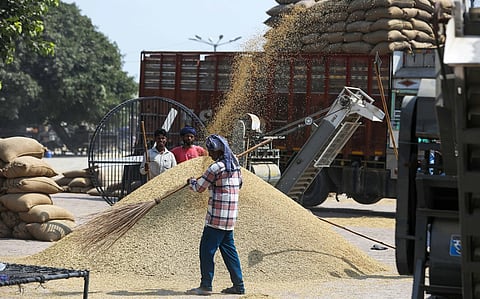

This is the fifth of a 7-part series. Read the first, second, third, fourth, sixth and seventh parts
The floods this year in Punjab have caused a drop in the prices of the state’s famed aromatic Basmati rice, and farmers are in despair.
The Pusa 1121 (about 40 per cent) and Pusa 1509 (25 per cent) varieties dominate Punjab’s more than 650,000 hectares of Basmati cultivation. They are usually grown along the banks of the Ravi and Sutlej rivers.
Down To Earth travelled about 30 kilometres from the Ravi, near Majjupura village in Amritsar district. The Basmati grown here is mainly of the Pusa 1509 variety. Amritsar district alone accounts for 146,000 hectares, i.e., 21.75 per cent of the total Basmati area.
In Majjupura, Gurnoor Singh is harvesting his fields with a traditional harvester combine machine. Singh said he recently sat in the Amritsar mandi (wholesale market) for three days to sell his paddy, eventually managing to sell it at Rs 2,500 per quintal.
He added that due to the intense and unusual rainfall in August, his fields suffered a loss of 10-12 quintals per acre. Pusa 1509 ripens in approximately 110-115 days (3.5 months) and yields about 20-25 quintals per acre. Gurnoor says that 50 per cent of his fields were damaged. Last year, this Basmati paddy sold for Rs 3,200 per quintal in the mandi. This year, the crop was affected by rainfall and floods. Market rates are low as well.
Most farmers in Punjab cultivate on leased land. Gurnoor had leased 20 acres at Rs 70,000 per acre. The difference in mandi prices of about Rs 700 per quintal, coupled with the loss of roughly half the crop, caused him a huge setback.
Tejender Singh, who exports Basmati under the Lal Kila brand, explained that if rainfall and floods caused a 10-12 per cent loss of Basmati in Punjab, it would not significantly affect exports. Pakistan’s Basmati-growing regions in its own Punjab province—Gujranwala, Gujrat, Lahore, Faisalabad, Multan, Sahiwal, Bahawalpur, Dera Ghazi Khan and Sargodha—have suffered substantial losses (up to 16 per cent), and the Basmati area in Punjab (India) was already smaller than usual.
Baljinder Singh, who reached the Amritsar grain market to sell Pusa 1509, says his yield has dropped by about 5 quintals per acre this year. He asked, “I don’t understand—when the Basmati area is smaller and losses occurred due to rain and floods, total production should be low, and we should get higher rates. Instead, we are getting about Rs 800 less than last year.”
The central government, after assessing the floods, announced Rs 1,600 crore in aid for Punjab. The state was declared “severely flood-affected” and also approved a 50-year soft loan of Rs 595 crore for repairing public infrastructure. However, Punjab’s losses far exceed the aid provided.